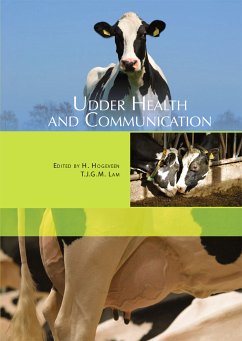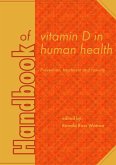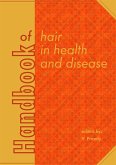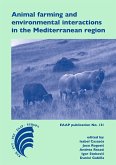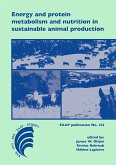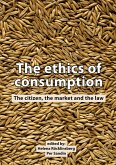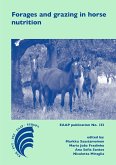Udder Health and Communication (eBook, PDF)
102,72 €
inkl. MwSt.
Sofort per Download lieferbar

0 °P sammeln
Udder Health and Communication (eBook, PDF)
- Format: PDF
- Merkliste
- Auf die Merkliste
- Bewerten Bewerten
- Teilen
- Produkt teilen
- Produkterinnerung
- Produkterinnerung

Bitte loggen Sie sich zunächst in Ihr Kundenkonto ein oder registrieren Sie sich bei
bücher.de, um das eBook-Abo tolino select nutzen zu können.
Hier können Sie sich einloggen
Hier können Sie sich einloggen
Sie sind bereits eingeloggt. Klicken Sie auf 2. tolino select Abo, um fortzufahren.

Bitte loggen Sie sich zunächst in Ihr Kundenkonto ein oder registrieren Sie sich bei bücher.de, um das eBook-Abo tolino select nutzen zu können.
In dairy industries throughout the world there is a desire to optimize udder health. An improved udder health will lead to improved animal welfare, improved production efficiency and a reduction of the use of antibiotics. To improve udder health, first of all, technical knowledge on issues such as treatment, milking, infectious pressure and host resistance is important. However, over the years we learned that knowledge alone is not enough: knowledge has to be used. And for knowledge to be used, farmers have to be motivated. This requires knowledge about motivation and communication. In this…mehr
- Geräte: PC
- ohne Kopierschutz
- eBook Hilfe
- Größe: 4.01MB
- Upload möglich
Andere Kunden interessierten sich auch für
![Handbook of vitamin D in human health (eBook, PDF) Handbook of vitamin D in human health (eBook, PDF)]() Handbook of vitamin D in human health (eBook, PDF)187,25 €
Handbook of vitamin D in human health (eBook, PDF)187,25 €![Handbook of hair in health and disease (eBook, PDF) Handbook of hair in health and disease (eBook, PDF)]() Handbook of hair in health and disease (eBook, PDF)139,10 €
Handbook of hair in health and disease (eBook, PDF)139,10 €![Animal farming and environmental interactions in the Mediterranean region (eBook, PDF) Animal farming and environmental interactions in the Mediterranean region (eBook, PDF)]() Animal farming and environmental interactions in the Mediterranean region (eBook, PDF)79,18 €
Animal farming and environmental interactions in the Mediterranean region (eBook, PDF)79,18 €![Energy and protein metabolism and nutrition in sustainable animal production (eBook, PDF) Energy and protein metabolism and nutrition in sustainable animal production (eBook, PDF)]() Energy and protein metabolism and nutrition in sustainable animal production (eBook, PDF)123,05 €
Energy and protein metabolism and nutrition in sustainable animal production (eBook, PDF)123,05 €![The ethics of consumption (eBook, PDF) The ethics of consumption (eBook, PDF)]() The ethics of consumption (eBook, PDF)84,53 €
The ethics of consumption (eBook, PDF)84,53 €![Forages and grazing in horse nutrition (eBook, PDF) Forages and grazing in horse nutrition (eBook, PDF)]() Forages and grazing in horse nutrition (eBook, PDF)92,02 €
Forages and grazing in horse nutrition (eBook, PDF)92,02 €![Proceedings of the Xth International Scientific Congress in Fur Animal Production (eBook, PDF) Proceedings of the Xth International Scientific Congress in Fur Animal Production (eBook, PDF)]() Proceedings of the Xth International Scientific Congress in Fur Animal Production (eBook, PDF)85,60 €
Proceedings of the Xth International Scientific Congress in Fur Animal Production (eBook, PDF)85,60 €-
-
-
In dairy industries throughout the world there is a desire to optimize udder health. An improved udder health will lead to improved animal welfare, improved production efficiency and a reduction of the use of antibiotics. To improve udder health, first of all, technical knowledge on issues such as treatment, milking, infectious pressure and host resistance is important. However, over the years we learned that knowledge alone is not enough: knowledge has to be used. And for knowledge to be used, farmers have to be motivated. This requires knowledge about motivation and communication. In this book, recent knowledge on technical udder health issues is combined with knowledge on motivation and communication. A large number of descriptions of mastitis control programs that are being carried out worldwide is combined with more specific studies. These are aimed at effective advising, motivation and communication strategies, economics, and technical studies on mastitis control and prevention. Therefore, this book provides an applied source of information for all that are willing to improve udder health.
Produktdetails
- Produktdetails
- Verlag: Wageningen Academic Publishers
- Seitenzahl: 429
- Erscheinungstermin: 10. März 2012
- Englisch
- ISBN-13: 9789086867424
- Artikelnr.: 43788511
- Verlag: Wageningen Academic Publishers
- Seitenzahl: 429
- Erscheinungstermin: 10. März 2012
- Englisch
- ISBN-13: 9789086867424
- Artikelnr.: 43788511
- Herstellerkennzeichnung Die Herstellerinformationen sind derzeit nicht verfügbar.
Preface.- Keynotes.- National mastitis control schemes: experiences from implementation of a nationwide scheme in Great Britain.- Countdown Downunder: development led innovation in a national mastitis control program.- The role of economics in motivating farmers to improve udder health.- Effective communication to improve udder health: can social science help?.- Part 1. Udder health programs and campaigns.- Effects of health and welfare planning on the use of antibiotics and udder health in European dairy farms.- The Danish udder health campaign: our milk – a pure pleasure.- ‘DEMO project udder health’: a first step towards a better udder health and milk quality in Flanders (Belgium).- Improvement of udder health following implementation of herd health plans in organic dairy farms: results of a pilot study in Germany.- The effect of a national control program on mastitis occurrence in the Netherlands.- €uroMilk mastitis control programme – a pilot study.- CellCheck-a national initiative.- Preventive animal health concepts in organic dairy farming: results of an interdisciplinary intervention study on mastitis and metabolic disorders in Germany.- Online mastitis survey in Flanders, Belgium: first descriptive results.- Part 2. New approaches in mastitis control.- Bulk milk quality: can it be improved by dairy farm audits?.- Internet data services from maritime quality milk: tools for tracking milk quality.- Systems analysis of high somatic cell counts on dairy farms.- Part 3. Motivation and communication strategies.- A Bayesian approach demonstrating that incorporation of practitioners’ clinical beliefs into research design is crucial for effective knowledge transfer.- Enhancing udder health with clinical communication skills: evidence based communication frameworks for the 22 century.- Udder health management improvement: Insights from agent-based modeling.- Usage of milking gloves and teat sealer on German dairy farms.- Communication research from otherhealthcare disciplines and its application to udder-health management.- Attitudes with regard to animal management of farmers with an automatic milking system and their relationship with udder health.- Farmer-veterinarian communication in the new Danish herd health program: changing responsibilities in relation to mastitis treatment and udder health promotion.- Dairy farmers’ knowledge, attitude and behaviour towards udder health in Switzerland.- Impact of communication strategies for milkers on udder health program.- Part 4. The effective advisor.- Potentials and limitations of systematic clinical examinations in farmer-veterinarian collaboration for improved udder health in the new Danish herd health program.- Veterinary on-farm counselling on dairy farms: the veterinarians’ vision.- Organizing external communication in the veterinary practice.- Presenting uncertainty and variability to the decision maker: A computer program that uses Monte Carlo simulations to improve the management of the dry period.- Dairy farmer and the veterinarian: an issue of communication.- Part 5. Training to improve udder health.- Bilingual trainings for milkers in New York State: a success for quality milk.- A coordinated udder health training strategy in Quebec, Canada.- Focus courses.- Part 6. Economics.- Ex-ante assessment of profitability of a new control plan for mastitis as a motivation tool for dairy farmers.- Costs and benefits of mastitis management measures on individual dairy farms.- Estimating the impact of mastitis on the profitability of Irish dairy farms.- The effect of udder health on cow fertility: understanding the costs.- A partial budget analysis to estimate the economics of a mastitis vaccination program.- Determination of economic loss from depressed udder health.- Part 7. Mastitis diagnostics.- Characterization of MRSA from bulk tank milk of dairy herds using a commercial microarray.- Mastitis diagnostics: qPCR for Staphylococcus aureus genotype B in bulktank milk.- Identification of coagulase-negative Staphylococcus species by gas chromatography.- Real time PCR values for mastitis pathogens – relations to milk quality and herd characteristics in Danish dairy herds.- The use of strain typing as an on farm tool to highight particular points of interest in the control of Staphylococcus aureus mastitis.- Estimation of the diagnostic accuracy of a multiplex real-time PCR assay and bacteriological culture for four bovine intramammary pathogens.- Part 8. Treatment.- Promoting judicious antibiotic use: On-farm culture-based treatment strategies.- Efficacy of the selective treatment of clinical mastitis based on on-farm culture results.- Field study on acute mastitis with SIRS and different treatment regimes.- Efficacy of two fresh cow subclinical mastitis treatment programs.- Effect of the combination of Tylan 200R & Penicillin G in the treatment of mastitis caused by Staphylococcus aureus and/or Streptococcus uberis.- Use of Tylan 200R for the treatment of mastitis caused by Staphylococcus aureus and/or Streptococcus uberis.- Therapeutic effects of lactation treatment of bovine subclinical Staphylococcus aureus mastitis with penicillin.- In vitro activity profile of a kanamycin and cefalexin combination against coagulasenegative staphylococci and correlation between MIC and disk zone sizes.- Part 9. Treatment evaluation.- Monitoring treatment outcomes: understanding and managing expectations.- Use of in-line measurements of somatic cell count to evaluate treatment efficacy of subclinical bovine Staphylococcus aureus mastitis.- ‘Therapy evaluation’: a useful tool for practitioners.- Dynamics of udder infection and effect of dry cow therapy validated by test day samples.- Part 10. Infectious pressure.- Subclinical mastitis in Dutch dairy heifers in early lactation and associated risk factors.- Risk factors associated with bacteriological quality of bulk tank milk in the Netherlands.- The efficacy of two iodine teatdips based on naturally occurring new intramammary infections.- Manageable risk factors associated with incidence and elimination of Staphylococcus aureus intramammary infections.- Factors influencing average herd somatic cell count in France in 2005 and 2006.- Risk factors associated with intramammary infections caused by the more pathogenic CNS-species.- Management of udder-thigh dermatitis on dairy cattle: epidemiological and bacteriological data.- Survey of bulk tank milk from all Danish dairy herds in 2009 and 2010 with realtime PCR.- Bedding conditioners for reduction of infectious pressure by mastitis pathogens –does their use make sense?.- Epidemiological and microbiological characteristics of Streptococcus uberis as mastitis pathogen in Swiss dairy herds.- Part 11. Host resistance.- Immunological response to an experimental intramammary inoculation with a killed Staphylococcus aureus strain in vaccinated and non-vaccinated lactating dairy cows.- Feasibility of high immune response (HIR) technology as a health management tool to characterize immune response profiles of dairy cattle.- Polymorphism screening and association study of CXCR1 with udder health in dairy heifers.- Genomic regions associated with somatic cell score in dairy cattle.- Efficacy of a Staphylococcus aureus biofilm-embedded bacterin against coagulasenegative staphylococci intramammary infections in dairy cows.- Effect of introducing OrbeSeal into a dry cow management programme and the impact on farm economics.- Part 12. Milking machine and milking technique.- Udder health in herds with automatic milking.- Alert preferences of dairy farmers working with automatic milking systems.- The role of sensor measurements in treating mastitis on farms with an automatic milking system.- Influence of milk yield and take-off settings on milking parlour performance and udder health.- Bacterial migration through teat canal related to liner action.- Classification of mouthpiece chamber vacuum records inmilking-time tests.- Key messages for an efficient udder preparation routine.- Effects of material, shape and mouthpiece venting on liner performance.- Wearing gloves for milking in Western New York: To wear or not to wear?.- New technology for vacuum-logging during milking helps advisor.- The world of post milking teat disinfectants: features, uses and risks.- Index.- Authors.
Preface.- Keynotes.- National mastitis control schemes: experiences from implementation of a nationwide scheme in Great Britain.- Countdown Downunder: development led innovation in a national mastitis control program.- The role of economics in motivating farmers to improve udder health.- Effective communication to improve udder health: can social science help?.- Part 1. Udder health programs and campaigns.- Effects of health and welfare planning on the use of antibiotics and udder health in European dairy farms.- The Danish udder health campaign: our milk – a pure pleasure.- ‘DEMO project udder health’: a first step towards a better udder health and milk quality in Flanders (Belgium).- Improvement of udder health following implementation of herd health plans in organic dairy farms: results of a pilot study in Germany.- The effect of a national control program on mastitis occurrence in the Netherlands.- €uroMilk mastitis control programme – a pilot study.- CellCheck-a national initiative.- Preventive animal health concepts in organic dairy farming: results of an interdisciplinary intervention study on mastitis and metabolic disorders in Germany.- Online mastitis survey in Flanders, Belgium: first descriptive results.- Part 2. New approaches in mastitis control.- Bulk milk quality: can it be improved by dairy farm audits?.- Internet data services from maritime quality milk: tools for tracking milk quality.- Systems analysis of high somatic cell counts on dairy farms.- Part 3. Motivation and communication strategies.- A Bayesian approach demonstrating that incorporation of practitioners’ clinical beliefs into research design is crucial for effective knowledge transfer.- Enhancing udder health with clinical communication skills: evidence based communication frameworks for the 22 century.- Udder health management improvement: Insights from agent-based modeling.- Usage of milking gloves and teat sealer on German dairy farms.- Communication research from otherhealthcare disciplines and its application to udder-health management.- Attitudes with regard to animal management of farmers with an automatic milking system and their relationship with udder health.- Farmer-veterinarian communication in the new Danish herd health program: changing responsibilities in relation to mastitis treatment and udder health promotion.- Dairy farmers’ knowledge, attitude and behaviour towards udder health in Switzerland.- Impact of communication strategies for milkers on udder health program.- Part 4. The effective advisor.- Potentials and limitations of systematic clinical examinations in farmer-veterinarian collaboration for improved udder health in the new Danish herd health program.- Veterinary on-farm counselling on dairy farms: the veterinarians’ vision.- Organizing external communication in the veterinary practice.- Presenting uncertainty and variability to the decision maker: A computer program that uses Monte Carlo simulations to improve the management of the dry period.- Dairy farmer and the veterinarian: an issue of communication.- Part 5. Training to improve udder health.- Bilingual trainings for milkers in New York State: a success for quality milk.- A coordinated udder health training strategy in Quebec, Canada.- Focus courses.- Part 6. Economics.- Ex-ante assessment of profitability of a new control plan for mastitis as a motivation tool for dairy farmers.- Costs and benefits of mastitis management measures on individual dairy farms.- Estimating the impact of mastitis on the profitability of Irish dairy farms.- The effect of udder health on cow fertility: understanding the costs.- A partial budget analysis to estimate the economics of a mastitis vaccination program.- Determination of economic loss from depressed udder health.- Part 7. Mastitis diagnostics.- Characterization of MRSA from bulk tank milk of dairy herds using a commercial microarray.- Mastitis diagnostics: qPCR for Staphylococcus aureus genotype B in bulktank milk.- Identification of coagulase-negative Staphylococcus species by gas chromatography.- Real time PCR values for mastitis pathogens – relations to milk quality and herd characteristics in Danish dairy herds.- The use of strain typing as an on farm tool to highight particular points of interest in the control of Staphylococcus aureus mastitis.- Estimation of the diagnostic accuracy of a multiplex real-time PCR assay and bacteriological culture for four bovine intramammary pathogens.- Part 8. Treatment.- Promoting judicious antibiotic use: On-farm culture-based treatment strategies.- Efficacy of the selective treatment of clinical mastitis based on on-farm culture results.- Field study on acute mastitis with SIRS and different treatment regimes.- Efficacy of two fresh cow subclinical mastitis treatment programs.- Effect of the combination of Tylan 200R & Penicillin G in the treatment of mastitis caused by Staphylococcus aureus and/or Streptococcus uberis.- Use of Tylan 200R for the treatment of mastitis caused by Staphylococcus aureus and/or Streptococcus uberis.- Therapeutic effects of lactation treatment of bovine subclinical Staphylococcus aureus mastitis with penicillin.- In vitro activity profile of a kanamycin and cefalexin combination against coagulasenegative staphylococci and correlation between MIC and disk zone sizes.- Part 9. Treatment evaluation.- Monitoring treatment outcomes: understanding and managing expectations.- Use of in-line measurements of somatic cell count to evaluate treatment efficacy of subclinical bovine Staphylococcus aureus mastitis.- ‘Therapy evaluation’: a useful tool for practitioners.- Dynamics of udder infection and effect of dry cow therapy validated by test day samples.- Part 10. Infectious pressure.- Subclinical mastitis in Dutch dairy heifers in early lactation and associated risk factors.- Risk factors associated with bacteriological quality of bulk tank milk in the Netherlands.- The efficacy of two iodine teatdips based on naturally occurring new intramammary infections.- Manageable risk factors associated with incidence and elimination of Staphylococcus aureus intramammary infections.- Factors influencing average herd somatic cell count in France in 2005 and 2006.- Risk factors associated with intramammary infections caused by the more pathogenic CNS-species.- Management of udder-thigh dermatitis on dairy cattle: epidemiological and bacteriological data.- Survey of bulk tank milk from all Danish dairy herds in 2009 and 2010 with realtime PCR.- Bedding conditioners for reduction of infectious pressure by mastitis pathogens –does their use make sense?.- Epidemiological and microbiological characteristics of Streptococcus uberis as mastitis pathogen in Swiss dairy herds.- Part 11. Host resistance.- Immunological response to an experimental intramammary inoculation with a killed Staphylococcus aureus strain in vaccinated and non-vaccinated lactating dairy cows.- Feasibility of high immune response (HIR) technology as a health management tool to characterize immune response profiles of dairy cattle.- Polymorphism screening and association study of CXCR1 with udder health in dairy heifers.- Genomic regions associated with somatic cell score in dairy cattle.- Efficacy of a Staphylococcus aureus biofilm-embedded bacterin against coagulasenegative staphylococci intramammary infections in dairy cows.- Effect of introducing OrbeSeal into a dry cow management programme and the impact on farm economics.- Part 12. Milking machine and milking technique.- Udder health in herds with automatic milking.- Alert preferences of dairy farmers working with automatic milking systems.- The role of sensor measurements in treating mastitis on farms with an automatic milking system.- Influence of milk yield and take-off settings on milking parlour performance and udder health.- Bacterial migration through teat canal related to liner action.- Classification of mouthpiece chamber vacuum records inmilking-time tests.- Key messages for an efficient udder preparation routine.- Effects of material, shape and mouthpiece venting on liner performance.- Wearing gloves for milking in Western New York: To wear or not to wear?.- New technology for vacuum-logging during milking helps advisor.- The world of post milking teat disinfectants: features, uses and risks.- Index.- Authors.
